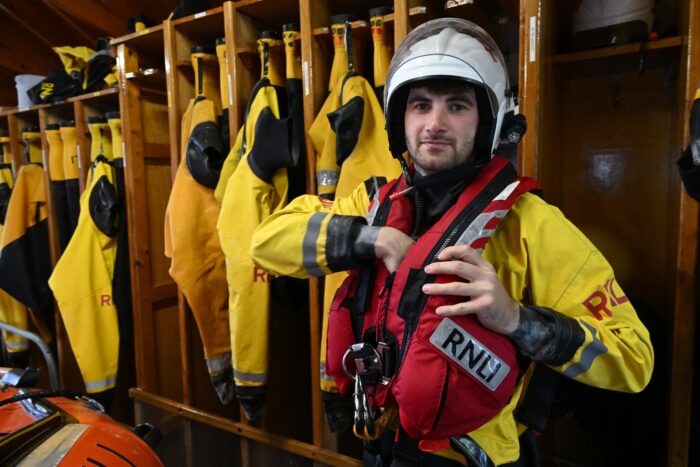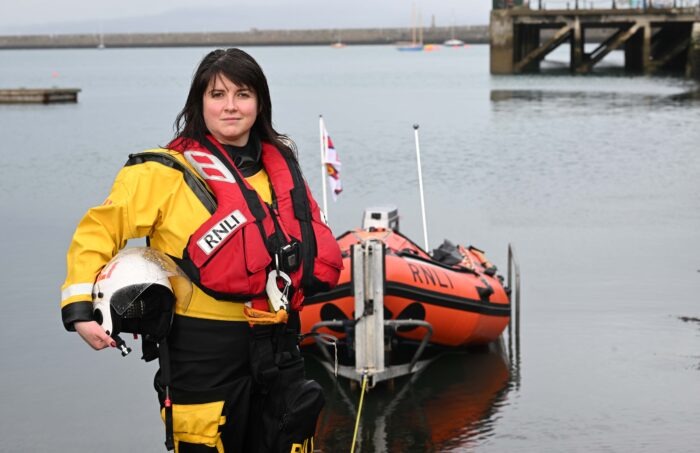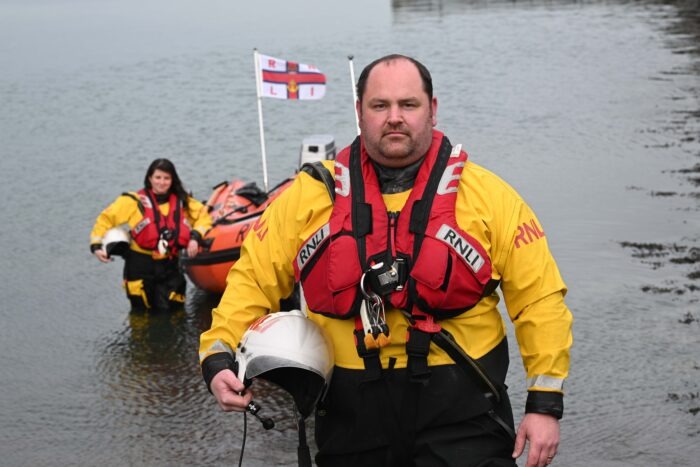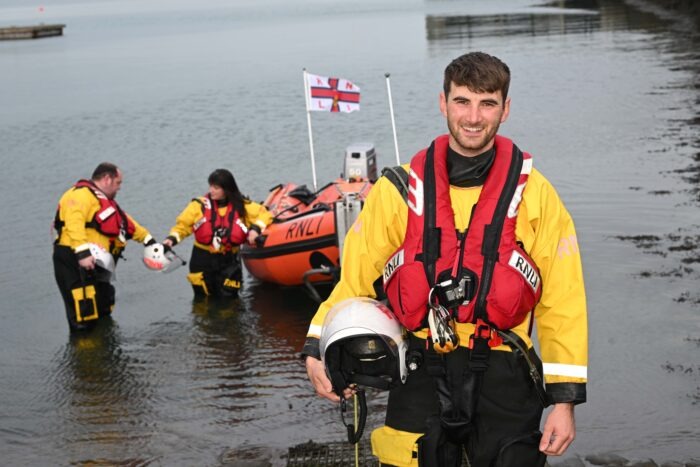Andrew Sykes was sitting on his couch watching Leinster play Leicester in the Champions Cup when the beeper on his hip began to vibrate. The message was clear and it told him to go immediately to the Royal National Lifeboat Institution’s inshore boat, a bright orange rib stored near the entrance to Dún Laoghaire’s historic East pier, some 163 yards of granite completed in 1767.
It was just after 8pm, and a member of the public had just notified the Irish Coast Guard that someone was in the water. Sykes, 26, felt his heart drop. He knew that Storm Kathleen had just passed and that conditions at sea remained treacherous. But he raced the kilometre and a half on his bicycle from his home in Glenageary, arriving there in three-and-a-half minutes.
Sykes manages the boathouse in the Royal St George Yacht Club in Dún Laoghaire Harbour. He is also a powerboat instructor so he knew the varied conditions in Dublin Bay intimately, long before he had even started volunteering with the RNLI more than four years ago. As other volunteers prepared the boat for departure, he quickly put on his drysuit and life jacket.

His colleague Ailbhe Smith, 32, arrived shortly after. She had been asleep at her home in Dún Laoghaire when she got the call. Gary Hayes was next. He had been at home in Sallynoggin with his wife Lisa putting his three children to bed when his pager went off. He had dropped everything and driven as fast as he could to the RNLI base.
As he arrived, a member of the public was leaving, but not before informing the RNLI that a child was in the water off the East pier and that it had been in the freezing water for 15 to 20 minutes.
A child, with their smaller lung capacity, can drown rapidly so every moment counted.
Sheltered water
Hayes, who works in the marina in Dún Laoghaire and was named the Christine Buckley Volunteer of the Year last year, had joined the RNLI at just 17 and was the most experienced member of the team. Now 39, he piloted the boat, while Smith and Sykes crouched in front as their rescue rib roared at 25 knots across the calm sheltered water towards the lighthouse in Dún Laoghaire.
Once the boat left the harbour it encountered two-metre-high waves causing it to slow, but Hayes deftly guided it onwards, dodging the lobster pots which litter the bay. As the rib rounded the elbow of the pier, the RNLI team could see a crowd of frantic people lining the walls pointing at the water. This saved them vital time. As the child was so small, and the waves so large, they couldn’t see her. The guidance was crucial. They raced towards where the people were pointing to, hoping they were not too late.
Walk amid the chaos
On Saturday evening, I was walking along Dún Laoghaire pier with my father Lorcan. It was windy, but the sun was shining and the last of Storm Kathleen seemed to have passed.
As we walked, there was suddenly shouting from the other side of the pier, the side exposed to the sea. We hopped up on one of the blue benches that dot the East pier and saw the chaos. A group of young men were pulling their friend out of the water after he had been thrown back onto the rocks, his knees sliced. It took me a moment to realise he had been trying to reach a small figure being thrown up and down just twenty metres away but behind fierce waves that were hitting the rocks hard.
A terrible sound emanated from a distressed man on the shore who clearly knew the child.
I then heard a siren in the distance, and a squad car raced up the pier. A Guard jumped out and was soon joined by others who brought the crowd safely back to the walls of the pier.
Behind me, I could see the RNLI boat accelerating across the protected water of the interior of the East and West piers before it disappeared as it rounded the lighthouse. It seemed like an age before the rib emerged once again, but, in reality, it was probably only two minutes.
I thought I saw the child moving, but by now she had been in the treacherous water for a long time. As the rib came closer I took out my phone and hit record. I hoped I wasn’t recording the final moments of someone’s life.
A rib and a rescue
The RNLI crew had trained for this moment, but the conditions were exceptionally difficult. “We were relying on everyone up on the pier to point to where she was,” Hayes would later recall. “It was only when they were pointing that we had an idea where to go.”
An orange jacket of a coast guard stood out on the pier, so Hayes tracked that person while his eyes swept the waves for the girl. “We still couldn’t see her until we got to about ten metres away roughly. It was only then that she saw us, and she called out for help. That was very important, as we now knew she was alive,” he said.
The rib slowed down as it tried to pull alongside the child in the water while ensuring the girl was safe and that their rib wasn’t dashed against the rocks.
“We could see her eyes were wide open, and she was calling for help,” Sykes said. “She knew we were there, so we knew she was alert. I could see she was face up on her back with her arms out wide. Her jacket was holding pockets of air which was a key reason why she was still afloat. As we tried to get close, the power of the waves and their surge up and down the back of the pier was pushing her one way and pushing us the other way.”
Hayes initially told Sykes to wait a second before jumping in, as he needed to be sure he had the engine of the rib away from his colleague and the girl. A few seconds later, it was time.
“Will I go in the water?” Sykes said.
“Yeah, get in as fast you can,” Hayes replied.
It was a calculated decision. They had been unable to get the girl in the boat at their first attempt. “The crew knew what was happening,” Sykes said. “I didn’t just take a leap of faith. The whole boat knew I was going in the water. The reason I did was that we were struggling to get alongside her due to the strong waves. There was the risk of how long the air is going to stay in her jacket.”
Over the side
Sykes had his dry suit and life jacket on so he knew once he reached the girl that he could prevent her sinking. “It was much safer to get into the water and get hands on her, just to make sure that we have her,” he said.
He went over the side of the boat, and into the water. He put his body behind the girl, ensuring her head remained above the water. He pushed hard with his legs, trying to get her away from the rocks of the pier and to give his colleagues the chance to get close enough to her. He kept talking to the girl as he held her: “I told her she was going to be okay, and that I had her. But it was tough to talk during that period of time because there was a lot happening. Our priority was to get her back to the station”.

During the pandemic, Ailbhe Smith had had more time to think. She had studied mathematics at Trinity College Dublin before working with fintechs and in banking after graduating in 2010.
She joined a French bank and then spent a further two years in London working with the European Bank for Reconstruction and Development, before coming home in late 2017.
She joined a rapidly growing fintech company, and then moved into investment banking with TD Securities. Smith had sailed out of Dún Laoghaire, but it was too much of a commute for her job in the city centre so she’d never thought of living there. But during the pandemic, she decided to move to the coastal south Dublin town.
Training for this moment
“I’d always thought if I got a chance, I’d love to volunteer with the RNLI,” she said. She knew about the important work that it performed. When she was 16, she witnessed the RNLI rescue someone at night after they were swept out to sea off the coast of Rosses Point, a picturesque village in Sligo.
“When I moved to Dún Laoghaire during Covid, I decided to see if they were short of volunteers,” she said, “and they were and I haven’t looked back since.”
Last summer, Smith decided to take a career break. She left her job to become a full-time regional delivery partner with the RNLI. She’d been flat out during Storm Kathleen with the RNLI, but now she was in the boat that Hayes was skilfully guiding to get close to the girl. “We did a lot of training in terms of man-overboard recovery,” Smith said. “We have a 50-kilo dummy that we bring out and we practise recovering it with all the different techniques we would use to recover a casualty or crew member, conscious or unconscious.

“In real situations, you have the adrenaline and the worry, but you also have the training so muscle memory kicks in. It was: Grab Andrew and pull him closer to the boat, then grab the casualty and get her off him and into the boat as fast as possible.”
Hayes added: “As I am driving I have to constantly risk-assess the situation. Before Andrew got back into the boat, I’d looked behind for any more big waves or anything coming in.
“If it’s not safe, I’m not going to let go of the engine. I know Andrew and he’s young and very fit, so he’s well able to pull himself into the boat, but just at the particular moment he did so a wave kind of lifted him, so I leaned over and just pulled him into the boat.”
Rescue position
With the waves continuing to surge, Hayes swung the boat around and raced back to the safety of the mouth of the piers. Smith and Sykes turned the child onto her side, into the rescue position. “She was alert. She wasn’t talking but she was making noises which is always good,” Hayes said. “As we left the scene, and came around the elbow of the harbour, she started to go downhill. That just happens with kids. They can go downhill very quickly. Our priority was to get her back to the station, and we knew it was less than five minutes away and ambulances were waiting.”
RNLI shore crew were waiting with blankets, as the girl was shaking and hypothermic from her time in the sea. “We started to warm her up, take her wet clothes off, and give her oxygen,” Hayes said.
Paramedics from the Dublin Fire Brigade took over the girl’s care after landing. A few minutes later, the Ambulance Service arrived. A rescue helicopter had arrived in case it was needed, and it now hovered above the harbour as the ambulance took the seven-year-old girl to hospital and treated her for non-life threatening injuries. She had made it.
Good outcome
After cleaning the boat and preparing for it to go again, the RNLI volunteers had a debrief. They discussed what had happened, and what lessons were learned. They had worked closely with the other rescue services training for these events.

This had been a good outcome, but it didn’t always turn out that way, so it was important for volunteers to support each other. The girl had survived partly because of fortune. The air pockets in her jacket had helped, but she had positioned herself on her back in a star shape with her ears in the water, and had not panicked.
The RNLI had run campaigns promoting Float to Live; whether she knew about it or not, the child had demonstrated how this technique could keep people alive long enough to be saved. After the volunteers finished their debrief, they left their base, and faded into the now dark streets of Dún Laoghaire.
Gary Hayes drove home to his family. His three daughters, aged one, seven and eight, were fast asleep but he went in and hugged them anyway.
The video taken on Saturday night of the Dún Laoghaire rescue was seen by one million people on social media, and featured on television and in most national news outlets in Ireland. The speed and the professionalism of the volunteer-powered RNLI working with Ireland’s rescue services was awe-inspiring. To support the RNLI click here.


